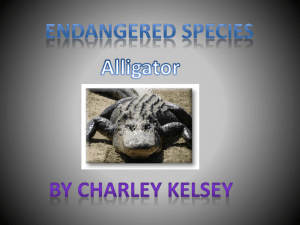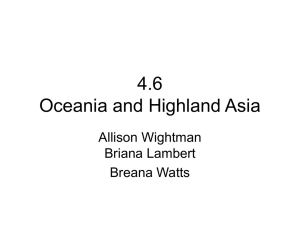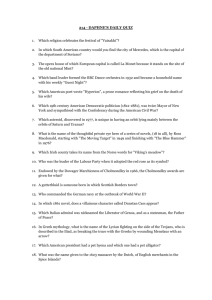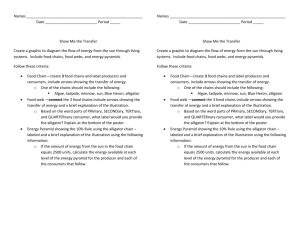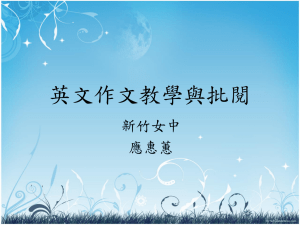Wildlife Resources Division - Georgia Public Broadcasting
advertisement
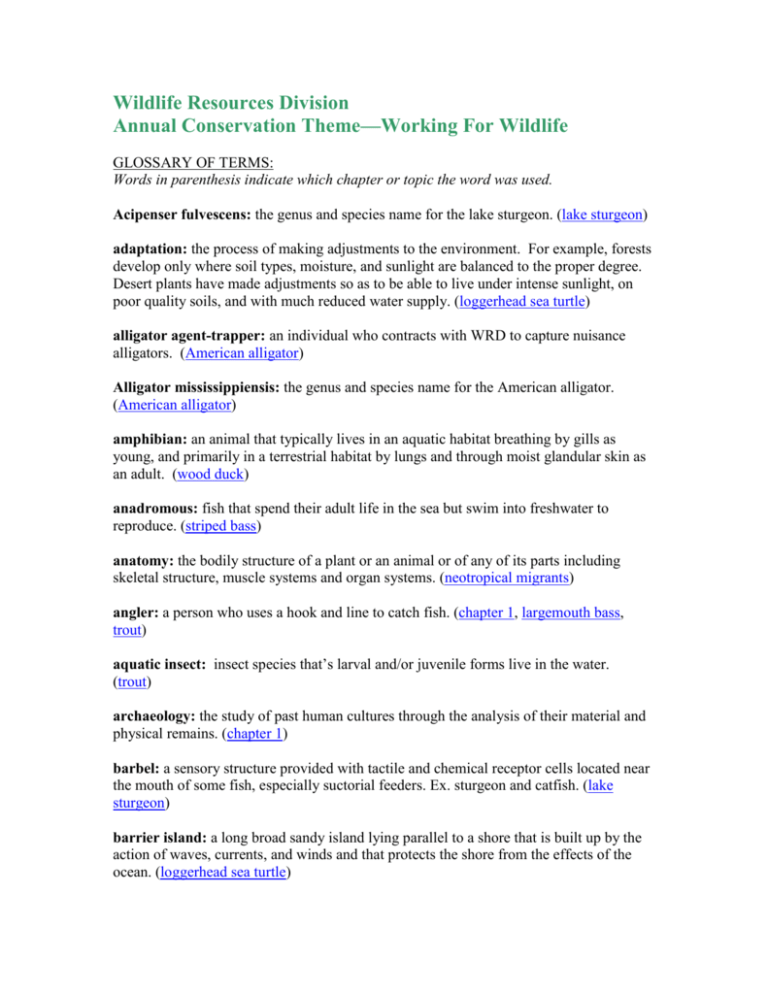
Wildlife Resources Division Annual Conservation Theme—Working For Wildlife GLOSSARY OF TERMS: Words in parenthesis indicate which chapter or topic the word was used. Acipenser fulvescens: the genus and species name for the lake sturgeon. (lake sturgeon) adaptation: the process of making adjustments to the environment. For example, forests develop only where soil types, moisture, and sunlight are balanced to the proper degree. Desert plants have made adjustments so as to be able to live under intense sunlight, on poor quality soils, and with much reduced water supply. (loggerhead sea turtle) alligator agent-trapper: an individual who contracts with WRD to capture nuisance alligators. (American alligator) Alligator mississippiensis: the genus and species name for the American alligator. (American alligator) amphibian: an animal that typically lives in an aquatic habitat breathing by gills as young, and primarily in a terrestrial habitat by lungs and through moist glandular skin as an adult. (wood duck) anadromous: fish that spend their adult life in the sea but swim into freshwater to reproduce. (striped bass) anatomy: the bodily structure of a plant or an animal or of any of its parts including skeletal structure, muscle systems and organ systems. (neotropical migrants) angler: a person who uses a hook and line to catch fish. (chapter 1, largemouth bass, trout) aquatic insect: insect species that’s larval and/or juvenile forms live in the water. (trout) archaeology: the study of past human cultures through the analysis of their material and physical remains. (chapter 1) barbel: a sensory structure provided with tactile and chemical receptor cells located near the mouth of some fish, especially suctorial feeders. Ex. sturgeon and catfish. (lake sturgeon) barrier island: a long broad sandy island lying parallel to a shore that is built up by the action of waves, currents, and winds and that protects the shore from the effects of the ocean. (loggerhead sea turtle) bioindicator: an animal or plant that serves like the “canary in the coal mine,” whose health or existence indicates the general health, safety, or condition of the environment. (neotropical migrants) biological surplus: the number of individuals that can be removed from a population without negatively impacting the overall population. (black bears) biotic community: any grouping of plants and/or animal populations of different organisms that are found living together in a particular environment; the organisms interact and give the community a structure. bottom feeder: 1. a fish or other animal that feeds on the bottom of a body of water. 2. one that feeds low on the food chain. (lake sturgeon) bottom land: low-lying land along a river or stream. (wood duck) brackish water: water that contains low to moderate amounts of dissolved salts. Brackish water is more salty than freshwater but not as salty as ocean water. (largemouth bass, wood duck) brood: (noun) the offspring of a bird or mammal. (verb) the act of adult birds wrapping their wings around their offspring and use their own body heat to keep the offspring warm or shield them from the sun. (wood duck, wild turkey) brood-rearing season: the time of year during which young are cared for by parents, typically in the spring. (wood duck) captivity: wild animals that are held in confinement. (American alligator) carapace: a bony or chitinous case or shield covering the back or part of the back of an animal such as a turtle or crab. (loggerhead sea turtle) carnivore: an animal whose diet consists primarily of meat. Carnivores are specialized by having strong powerful jaws and well-developed canine teeth. They may be predators or carrion eaters. Compare herbivore, omnivore. (black bears, American alligator) carrion: the dead and rotting body of an animal. (bald eagle, black bears, American alligator) carrying capacity: the maximum number of individuals or inhabitants that a given environment can support without detrimental effects. (black bears, white-tailed deer) cavity: a hole in a tree often used by wildlife species, usually birds, for nesting, roosting, and reproduction. (wood duck) clear-cutting: a method of harvesting timber by which all the trees in a given area are removed at one time. (wild turkey) clutch: the assemblage of eggs laid in one nest in a single nesting attempt. Clutch size is the total number of eggs in a clutch. The eggs laid by a bird or reptile in a single nesting attempt. (loggerhead sea turtle, neotropical migrants, wood duck, wild turkey) coastal bays: a body of water partially enclosed by land but with a wide mouth, affording access to the sea. (wood duck) cold-blooded: animals whose internal body temperature is regulated by their surrounding environment. (largemouth bass, loggerhead sea turtle, striped bass) coniferous forest: a woodland consisting mostly of conifers such as pine, fir, and spruce. (white-tailed deer) conservation: the wise and intelligent use of natural resources in a way that assures their continuing availability to future generations. (American alligator, white-tailed deer, wood duck) creel limit: the number of fish of a designated species that may be taken, caught, or killed during a specified period. For example, on most lakes the creel limit for largemouth bass is 10 fish per day per angler. (largemouth bass, striped bass, trout) cultural carrying capacity: the maximum number of individuals or inhabitants that people are willing to support or tolerate. (black bears) cultural resource: any definite location of past human activity identifiable through field survey, historical documentation, or oral evidence; includes archeological or architectural sites, structures, or places, and places of traditional cultural or religious importance to specified groups whether or not represented by physical remains. (chapter 1, black bears) current fronts: current fronts in coastal regions often occur in proximity to river mouths where large amounts of fresh water enter the ocean. Where oceanic and fresh water s meet, strong gradients of both salinity and often temperature are created. (loggerhead sea turtle) dabbling duck: ducks that frequent shallow marshes, ponds and rivers and “tip up” to feed. They feed with their body above water and take off vertically when startled; also called “puddle ducks.”--See Diving Duck. (wood duck) DDT: (dichloro diphenyl trichloroethane) a colorless contact insecticide, C14H9Cl5, toxic to humans and animals when swallowed or absorbed through the skin. It has been banned in the United States for most uses since 1972. (neotropical migrants) deciduous forest: a woodland composed primarily of broad-leaf trees that loose their leaves during the winter. (white-tailed deer, neotropical migrants) decomposing vegetation: dead vegetation that is being broken down into inorganic materials. (American alligator) den: an animals shelter. (black bears) desert: an arid region with little or no vegetation. (white-tailed deer) digestion: the process of converting food to products that can be used by the body. (American alligator) dissolved oxygen: The amount of oxygen contained in the water and available for animals to use for respiration. Dissolved oxygen contained naturally from two sources (1) as a by-product of photosynthesis in aquatic plants (i.e. algae) living in the water and (2) by the transfer of oxygen from the atmosphere into the water, such as occurs when water flows over rocks and forms air-filled bubbles that become incorporated into water. (trout) diurnal: active during the daylight hours. (neotropical migrants) diving duck: diving ducks frequent the larger, deeper lakes and rivers, and coastal bays and inlets. They dive to feed, often to depths of several feet, and take wing from a running start. —See dabbling duck. (wood duck) dumping: term used to describe the act of laying eggs in the nest of another of the same species, so that the biological parent does not raise its own young. (wood duck) economically valuable: animals or their parts that have a commercial value. (American alligator) ecosystem: a system formed by the interaction of a community of organisms with their physical environment. (neotropical migrants) emergent: used to discuss vegetation that grows form inundated soils to above the waterline. (wood duck) endangered species: 1. any plant or animal that is in danger of extinction throughout all or a significant portion of its range 2. any resident species which is in danger of extinction throughout all or a significant portion of its range, or one which is designated as endangered under the provisions of the Federal Endangered Species Act of 1973. (chapter 1, loggerhead sea turtle) Endangered Species Act: a 1966 U.S. Congressional Act intended to protect plant and animal species from becoming extinct. (American alligator) even-aged timber management: a system which a stand of trees are primarily of a single age class. (black bear) evolution: all the changes that have transformed life on Earth from its earliest beginnings to the diversity that characterizes it today. (loggerhead sea turtle) extinction: the condition of having been removed from existence. Compare extirpate. (bald eagle) extirpate: missing from native range but not extinct. Compare extinction. (black bear, lake sturgeon) extrinsic factors: in biological terms—features or characteristics associated with habitat that impact species survival. Ex. food availability, temperature, topography. (black bears) fall line: in Georgia, a geological line that roughly connects Augusts, Macon, and Columbus. (American alligator) fingerling: a stage of fish development that occurs after the yolk sac is absorbed until they reach an arbitrary size that typically ranges from 2 to 4- inches in length. (trout) fins: external appendages on a fish that propel and steer its body through the water. (largemouth bass, striped bass) fishing license: a permit that authorizes the bearer of the license to catch and harvest fish in public waters during a specified period of time. In Georgia, a fishing license to fish in public waters is required for anyone age 16 and older. (largemouth bass, striped bass) forb: a broad-leaved flowering plant such as sunflower and prairie clover; does not include grasses, trees, shrubs. (black bears) forest management: (1) Giving the forest proper care so it stays healthy and vigorous and provides the products and values the landowner desires. (2) Technical definition: Applying technical forestry principles and practices and business techniques (such as accounting, benefit-cost analysis, etc) to a forested area. fragmentation: the breaking up of large blocks of habitat into smaller isolated remnants. Fragmentation effects can lead to an increase in nest predators and nest parasitism. (neotropical migrants) freshwater: clean, unpolluted water without salinity. (chapter 1) fry: a recently hatched fish which still has a yolk-sac. (striped bass, trout) fusiform: a body shape that is wide near the middle and tapers at the head and tail, like a torpedo. (striped bass) game fish: legal designation for fish that are caught for sport. The harvest of most game fish are established in game and fish laws and regulations. (largemouth bass) game species or game animal: legal designation for animals that may be managed and hunted only under regulation. (chapter 1, white-tailed deer) gator hole: holes dug by alligators during times of drought that help preserve water in typical wetland situations. (American alligator) gills: an internal structure that allows a fish to absorb dissolved oxygen from the water and expel carbon dioxide. (largemouth bass, striped bass) grassland: any plant community in which grasses and/or legumes compose the dominant vegetation. (white-tailed deer) green tree reservoir (GTR): a forested lowland that is temporarily flooded during fall and winter to attract ducks; primarily mallards and wood ducks. It is designed to hold water while trees are dormant. This prevents permanent tree damage and possible death; hence the name “green tree” reservoir. (wood duck) greenspace: permanently protected land and water, including agriculture and forestry land, that is in its undeveloped, natural state or that has been developed only to the extent consistent with, or is restored to be consistent with, one or more listed goals for natural resource protection or informal recreation. (chapter 1) habitat: the arrangement of food, water, shelter or cover, and space suitable to species’ needs. (bald eagle, black bear, largemouth bass, American alligator, lake sturgeon, whitetailed deer, trout) hacking: the technique of rearing young birds in the wild by human hand, in the absence of their parents, with the hope that after the young fledge and reach adulthood, they will return to breed in their natal site. (bald eagle) harvest: catching and keeping an animal for the purposes of sport or food. (black bear, largemouth bass, striped bass) hatchling: a recently hatched animal. (loggerhead sea turtle, American alligator) herbivore: an animal that eats primarily vegetation, especially any of the planting eating mammals, such as ungulates (cows, deer etc.). Herbivores are characterized by having teeth adapted for grinding plants and alimentary canals specialized for digesting cellulose. Compare carnivore, omnivore. (white-tailed deer) heterocercal tail: in fish, a tail in which the tip of the vertebral column turns upward, extending into the dorsal lobe of the tail fin. Ex. sharks, sturgeon (lake sturgeon) hibernate: a sleeplike state in which some animals pass the winter months as a way of surviving food scarcity and cold weather. Various physiological changes occur, such as lowering of the body temperature and slowing of the pulse rate and other vital processes, and the animal live on its reserve of body fat. Animals that hibernate include bats, hedgehogs, and many fish, amphibians, and reptiles. (black bears) historic resource: a building, structure, site, district, or object which is significant in history, architecture, archeology, engineering, and culture. (chapter 1) hunting: the act of pursuing, shooting, killing, taking, or capturing wildlife legally. (chapter 1, black bear, white-tailed deer) illegal: an activity that is against the law. (American alligator) incubate: to warm eggs as by bodily heat, so as to promote embryonic development and the hatching of young. The period of time from when the eggs are laid to when they hatch. (bald eagle, loggerhead sea turtle, American alligator, wood duck, wild turkey) index: monitoring technique used to measure population trends without knowing the actual number of animals in a population. (black bear) intrinsic factors: in biological terms—features or characteristics associated with a species or species population that impacts its own survival. Ex. body size, dietary needs, population density. (black bears) invasive species: a plant or animal species that has the ability to significantly displace desirable species or reduce the yield of growing crops. (chapter 1) invertebrate: an animal without a backbone; invertebrates make up 95% of animal species. (loggerhead sea turtle, American alligator) keel: 1. a large plat projection on the birds sternum, that acts as an anchor for the birds flight muscles. 2. the force acting on a moving wing to counteract gravity and lift a bird off the ground. (neotropical migrants) keystone species: a species that has a major influence on community structure. (black bears) Lacey Act: a 1969 U.S. Congressional Act that limits the import and export of plants and animals, or their parts, that are considered to be endangered. (American alligator) lateral line: a specialized organ located on the side of a fish’s body that is used to detect vibrations in the water. In other words, the lateral line allows fish to hear movement over long distances. (largemouth bass, striped bass) license revenues: those funds that result from the sales of hunting and fishing licenses. (American alligator) Lyme Disease: a tick-borne disease cause by the spirochete bacterium Borrelia burgdorferi. Typically associated with a tick bite, a characteristic red rash expanding out to a diameter of 5 inches or more is a usual symptom. Often, symptoms are accompanied by a flu-like illness. If left untreated, infection can lead to chronic disease characterized by neurologic imparement. Fortunately, in the early stages this disease is treatable with antiobiotics. (white-tailed deer) mammal: a class of vertebrates that are warm-blooded animals having sweat lands whose secretion cools the skin and an insulating body covering of hair. All mammals have mammary glands, which secrete milk to nourish the young. Mammalian teeth are differentiated into incisors, canines, premolars, and molars and the middle ear contains three sound-conducting ear ossicles. The four-chambered heart enables complete separation of oxygenated and deoxygenated blood and a muscular diaphragm takes part in breathing movements, both of which ensure that the tissues are well supplied with oxygen. This, together with well-developed sense organs and brain, has enabled mammals to pursue an active life and to colonize a wide variety of habitats. (black bear, white-tailed deer, neotropical migrants, wood duck) management: the application of scientific knowledge and technical skills to protect, preserve, conserve, limit, enhance, or extend the value of wildlife and its habitat. (American alligator, white-tailed deer) marine: relating to the sea or ocean. (chapter 1) market hunting: capturing or killing wildlife for profit. Especially used to describe taking game in great numbers for sale in the market place. This practice was greatly curtailed in the U.S. with law changes that regulated the interstate commerce of wildlife—The Lacey Act of 1900. (neotropical migrants, wood duck, wild turkey) marsh: a more or less permanently wet area of mineral soil (as opposed to a peaty area), typically found around the edges of a lake or on an undrained river flood-plain. Colloquially, ‘marsh’ is often used interchangeably with ‘swamp’ and ‘bog’. (chapter 1, American alligator, wood duck) mast: fruits or nuts used as a food source by wildlife. Soft mast includes most fruits with fleshy coverings, such as persimmon, dogwood seed, or black gum seed. Hard mast refers to nuts such as acorns and beech, pecan, and hickory nuts. (black bear) midstory: from an ecological perspective, forests are often divided into vertical layers: the canopy, the midstory, and the understory. The midstory is the middle vertical layer of the forest where small trees and shrubs grow. (wild turkey) migrate/migratory: in wildlife usage, birds or other animals, which make annual migrations; i.e., travel distances in seasonal movements. Migrations may be great, or very short, depending on the species. (loggerhead sea turtle) migratory bird hunting stamp act of 1934: an act of the U.S. legislature created to establish a national license to hunt migratory waterfowl, with the fund from the Act going to wetland protection, waterfowl management, and the establishment of the National Wildlife Refuge System. (wood duck) migratory bird treaty act of 1918: an act of the U.S. legislature created to protect migratory bird species, their eggs, and their nests. It authorizes the Secretary of Agriculture to oversee hunting regulations and the sale and transport of migratory birds, and to prosecute violators of the act. (wood duck) milt: fish sperm. (largemouth bass, lake sturgeon) natal beaches: pertaining to birth; place of birth. (loggerhead sea turtle) native: a plant or animal species that was produced, grew, or originated in a certain region. (black bear, American alligator) natural community: see biotic community. (chapter 1) natural resources: products of the earth that can either be renewable or nonrenewable; see Renewable Resource or Nonrenewable Resource. (chapter 1, American alligator, white-tailed deer) neotropical migratory birds: birds that breed north of the Tropics (23ºN) and winter primarily in the new world (western hemisphere) tropics (between Tropic of Cancer and Tropic of Capricorn). (neotropical migrants, wood duck) nest parasitism: a number of bird species around the world lay their eggs in other birds’ nests, making the host parent raise their young. In North America, the main nest parasite is the brown-headed cowbird, which parasitizes songbirds throughout much of the eastern United States. (neotropical migrants) nesting season: the period of time when birds are nest building, incubating, and fledging young. (wood duck) nongame species or nongame animal: all wildlife species that are not commonly hunted, killed, or consumed by humans, such as songbirds and raptors. (chapter 1, neotropical migrants) nonrenewable resource: nonliving resources such as rocks and minerals that do not regenerate themselves and cannot be replaced in this geological age. Compare renewable resource. nuisance: an animal that bothers or is a danger to humans or their property. (American alligator) omnivore: an animal that eats both animal and vegetable matter. Compare carnivore, herbivore. (black bear) operculum: the bony, flap-like structure that covers and protects a fish’s gills. (striped bass) otolith: a small bone in the inner ear that aids fish with balance and hearing. (largemouth bass, striped bass) pair bonds: the temporary or permanent association formed between a female and male animal during courtship and mating. (wood duck) Partners In Flight: a cooperative partnership among federal, state and private organizations working internationally to conserve birds of the Western Hemisphere. (neotropical migrants) pecking order: the dominance hierarchy (wild turkey) pelagic (zone): the area of the ocean past the continental shelf, with areas of open water often reaching to very great depths. (loggerhead sea turtle, striped bass) pest: an animal viewed as a nuisance, not worthy to have around. (American alligator) pesticide: a chemical used to control undesirable species such as some insects. (neotropical migrants) physiology: all the functions of a living organism or any of its parts. (neotropical migrants) poaching: the act of hunting, trapping, or fishing illegally. (loggerhead sea turtle, American alligator) pod: a school or grouping of animals. (American alligator) pollinate: to fertilize a plant by transferring pollen from one plant’s anthers to another’s stigma. (neotropical migrants) pollution: contamination of soil, water, or atmosphere by the discharge of harmful substances. (chapter 1) pool: area of deep water in streams. (trout) population: the number of a particular species in a defined area. (black bears, whitetailed deer) poult: the young of the wild turkey, a wild turkey chick. (wild turkey) precocial, precocious: developing or maturing early; used to describe well-developed young birds that are capable of moving about shortly after birth. When young precocial birds hatch, they are mobile, their eyes are open, and they have down. Usually they follow the parents around, but are able to feed themselves. (wood duck) predation: the act of preying upon. (loggerhead sea turtle) predator: an animal that kills and eats other animals for food. (largemouth bass, American alligator, white-tailed deer, trout) prescribed fire or prescribed burning: the controlled application of fire to fuels in either a natural or modified state, under specified environmental conditions which allow the fire to be confined to a predetermined area and at the same time produce the intensity required to attain planned resource management objectives. (chapter 1) prey: an animal that is killed and eaten by another animal. (bald eagle, largemouth bass, loggerhead sea turtle, American alligator, striped bass) primary consumer: an animal that subsists on producers for nourishment, usually commonly referred to as a herbivore. (black bear) producer: organisms that are able to manufacture food from simple organic substances. protected species: plants and animal life that the Georgia Department of Natural Resources designated as subject to protection by law. (chapter 1, black bear, loggerhead sea turtle) pulpwood: a forestry term referring to the size and age of the trees in a forest. Pulpwood trees are used to make paper. (wild turkey) quota: the limited number of individual hunters who are allowed to participate in a particular hunt. (American alligator) radio telemetry: the monitoring, recording, and measuring of a living organism’s basic physiological functions by the use of telemetry techniques which involves transmission of data by wire, radio, or other means to receiving stations for recording and analysis. (lake sturgeon) rainforest: a dense tropical forest that grows in the hot, tropical regions of the world that is associated with heavy rainfall. (white-tailed deer) range: the geographic area where an animal occurs. (bald eagle, largemouth bass, American alligator, wood duck, wild turkey) raptor: literally means “to seize” and refers to the birds of prey, that have talons to catch and kill their prey. Includes such birds as eagles, hawks, kites, osprey, falcons, and harriers. (bald eagle, neotropical migrants) rare species: plants or animal life which, although not presently endangered or threatened, should be protected because of its scarcity. (chapter 1) redd: shallow depression in the streambed gravel in which a female trout deposits her eggs. (trout) relocated: animals that were captured and moved to a new location. (American alligator) renewable resource: a commodity or resource—such as plants and animals—that is replaceable by new growth and that has the capacity to renew itself when conditions for survival are favorable. Compare non-renewable resource. (chapter 1) reptile: any cold-blooded vertebrate of the class Reptilia including tortoises, turtles, snakes, lizards, alligators, crocodiles, and extinct forms. Reptiles have dry, scaly skin. They move by either creeping on short legs or crawling on their bellies. Most reproduce by laying eggs. (loggerhead sea turtle, American alligator, wood duck) research: scholarly or scientific investigation or inquiry into the living requirements of wildlife. (American alligator) reservoir: a man-made body of water (it is replenished by rain and river or stream flow), which is formed after a dam is built on a river, and is used for the collection and storage of water. In addition to providing municipal water supplies, reservoirs provide recreational areas, are used for irrigation, hydroelectric power, and flood control. (wood duck) riffles: a shallow, gravelly section in a stream where water is breaking over rocks or other partially submerged organic debris with swift current. Riffles are excellent areas for spawning by trout and other fishes. (trout) riparian: habitat associated with rivers and other waterways. (wood duck) run: a relatively straight section of stream with moderate depth and uniform velocity. Pools and riffles are connected by runs. (trout) rut: refers to the breeding period of mammals, especially deer, elk, and moose. During the rut, males exhibit specific behaviors to attract females. (white-tailed deer) sawtimber: a forestry term referring to the size and age of the trees in a forest. Sawtimber trees are old enough and large enough that they can be sawed into lumber at a sawmill. (wild turkey) scales: thin bony plates that cover the skin in overlapping rows. (largemouth bass, striped bass) school: a large group of fish, usually of the same species, that swims and feeds together. (striped bass) scutes: scale-like structure of bone; a bony external plate. (lake sturgeon) secondary consumer: an organism that feeds on primary consumers, commonly referred to a carnivore. (black bear) sedimentation: the transport of soil eroded from the land (usually by rainfall) into the stream where it settles onto the bottom and clogs the gravel and cobble. Sediment adversely impact the stream ecosystem by smothering trout redds and aquatic insects. (trout) shorebird: any of numerous wading birds including sandpipers and plovers that frequent mostly seashores and estuaries. They are typically long legged and are often associated with sandy beaches and mud flats where they feed on a wide range of invertebrates. (neotropical migrants, wood duck) size limit: a legal restriction on certain game fish that defines the length at which a species can be harvested. For example, on most lakes in Georgia, largemouth bass must be 12-inches or longer in length to be harvested. (largemouth bass, striped bass) skeletal: relating to an animals skeleton. (neotropical migrants) snag: a standing dead tree. (black bears) songbirds: birds of the Order Passeriformes. This is by far the largest Order of birds, including almost ½ of the world’s birds. They are distinguished from other birds by their unique split voice box or syrinx that allows them to generate such a variety of songs and calls. (neotropical migrants) sound: a long wide ocean inlet. (wood duck) spawn: the reproductive process in fish that includes laying large numbers of eggs in suitable habitats by the female and fertilizing them by male(s). (largemouth bass, lake sturgeon, striped bass, trout) spawning grounds: suitable habitat where fish lay and fertilize large numbers of eggs. (lake sturgeon) species: a population of individuals that are more or less alike and that are able to breed and produce offspring under natural conditions. (American alligator, white-tailed deer) speculum: a colored wing patch, generally iridescent and bright, and often a telltale field mark for puddle ducks. (wood duck) springhead: the upwelling of water from the ground. Springheads in the mountain are the source of water for streams. (trout) stocking: the act of relocating a fish from one water body into a different water body. (largemouth bass) strategy: a “game plan” used for management of our natural resources. (American alligator) submerged: lying under the surface of water. (American alligator) subspecies: a sub- division taxonomic species usually based on geographic distribution and sometimes physiological variations in appearance. (wild turkey) sustainable: natural resources that remain in existence through management. (American alligator) sustainable-use management: wise-use management of a natural resource to insure its continued existence. (American alligator) swamp: a wetland where soil is saturated and often inundated with water and trees are the dominant cover vegetation. (American alligator) tailwaters: a stretch of river immediately downstream of a dam whose water quality and quantity are dependent upon the water that passes from the reservoir through the dam and into the downstream stretch. (trout) talons: the long, sharp, curved claws found on raptor feet. (bald eagle) temperate ecosystem: ecosystems found in latitudes between those of the tropics (north of 23.5) and the arctic (south of 66º33’N). Most of the continental United States is made up of temperate ecosystems. Generally considered a region where climate doesn’t reach the extremes of tropical heat or arctic cold. (neotropical migrants) terrestrial: living or growing on land. (black bear) terrestrial insect: insect species that live on the land, not in the water. (trout) territory: dominance over a unit of habitat; an area defended by an animal against others of the same species. (black bears, white-tailed deer) threatened species: 1. a plant or animal present in its range but in danger because of a decline in numbers 2. any resident species which is likely to become an endangered species within the foreseeable future throughout all or a significant portion of its range or one that is designated as threatened under the Federal Endangered Species Act of 1973. (loggerhead sea turtle) timber management: see forest management. (chapter 1, white-tailed deer) torpor: 1. a state of lethargy or drowsiness into which some animals enter during the colder months of the year to conserve energy. A higher state of ability than hibernating animals. 2. a state of motor or mental inactivity with a partial suspension of sensibility. (black bears) understory: from an ecological perspective, forest are often divided into vertical layers: the canopy, the midstory, and the understory. The understory is the bottom vertical layer of the forest where forbs, grasses and other herbaceous vegetation grows from the ground to about 3 feet. (wild turkey) ungulate: a herbivorous mammal with hoofed feet. Ungulates are grouped into two orders—Artiodactyla and Perissodactyla. (white-tailed deer) unprovoked attack: an attack that was not brought about deliberately by the victim of the attack. (American alligator) unregulated hunting: the act of pursuing, shooting, killing, taking, or capturing wildlife in a manner without rules, laws, or guidelines. (white-tailed deer) unusual species: plant or animal life which exhibits special or unique features and because of these features deserves special consideration in its continued survival in the state. urbanization: the spread of urban development into the areas adjoining the edge of a city. (wild turkey) venison: deer meat. (white-tailed deer) vertebrate: animals with a bony internal skeletal system in which the backbone serves as the central support structure. (largemouth bass, striped bass) vulnerable: an animal that is susceptible or open to physical injury. (American alligator) wading bird: long-legged birds that feed in shallow areas of lakes, streams, ponds, and other waterways. Includes birds such as herons, egrets, ibises, and storks. (wood duck) water resource: the supply of groundwater and surface water in a given area. (chapter 1) waterfowl: birds of the Family Anatidae, including ducks, geese and swans. (neotropical migrants) waterfowl impoundment: a body of water, such as a reservoir, made by impounding and managed by controlling water levels to benefit waterfowl. (wood duck) weed line: large clumps of floating Sargassum weed that host a variety of small fishes and crustaceans on which sea turtles feed. (loggerhead sea turtle) wetland: any land area that tends to be regularly wet or flooded. (American alligator, wood duck) wild animal: any animal which is not considered wildlife and is not normally a domestics species. (chapter 1) wildlife: 1. animals that are not tamed or domesticated and includes, but is not limited to, insects, spiders, birds, reptiles, fish, amphibians, and mammals, if nondomesticated 2. any vertebrate or invertebrate animal life indigenous to the State of Georgia or any species introduced or specified by the Board of Natural Resources and includes fish, except domestic fish produced by state registered aquaculturists, mammals, birds, fish, amphibians, reptiles, crustaceans, and mollusks or any part thereof. (chapter 1, whitetailed deer) wildlife planting: plants that provide some form of habitat value for wildlife. (chapter 1) woodies: another name for wood duck used especially by bird watchers and waterfowl hunters. (wood duck) yolk-sac: a small, external extension of the digestive system in newborn fish (fry) which provides nourishment for a brief period of time until they are able to feed on prey. (striped bass, trout)
